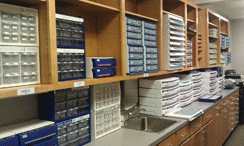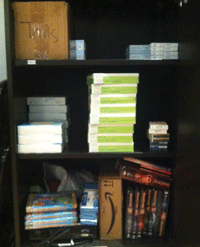Or, even less convenient, are they informed they’ll have to return to the practice when their order comes in?
Ultimately, if you decide not to stock a large inventory of contact lenses, do you risk losing a sale if the patient walks out the door empty-handed?
Maintaining an in-house contact lens inventory can be a careful balancing act—weighing cost, adequate space, and training and entrusting a staff member to oversee the task. With patient-friendly options now available—such as direct ship by the manufacturers to online ordering from practices’ websites—some ODs feel the need to keep a large contact lens inventory is not just antiquated, but can be detrimental to a practice’s bottom line.

| |
|
A stocked contact lens inventory, such as this one at the office of Steven Wilson, OD, encourages same-day sales, promotes patient loyalty and keeps Rxs in house.
|
“We’ve tried many different approaches over the years, from consignment to outright purchase and many options in between,” says optometrist Joseph Shovlin of Scranton, Pa. “You can invest a small fortune with little return, if not careful.”
Let’s look at two contrasting approaches—full inventory and no inventory, along with some variations in between.
Large Inventory
Some optometrists maintain that the convenience of having a lens in stock promotes patient loyalty, ensures a sale and ultimately dissuades patients from filling their prescriptions at a big box store or online retailer.
If you feel a well-stocked inventory is essential, some of your colleagues offer these tips to better manage your contact lens supply:
• What to stock. Optometrist Steven Wilson maintains a well-stocked contact lens inventory of two brands of spherical lenses at his Valdosta, Ga. practice. “Careful selection of lenses in both trial and revenue boxes is achieved by choosing lenses that span a broad patient base, are of high quality, have wide power and fitting parameters, and are approved by most vision insurance plans as ‘covered lenses’ within the patient’s vision insurance benefits,” he says.
Dr. Wilson generally maintains an inventory of lenses with powers ranging from -0.75 to -10.00 and from +0.75 to +6.00 to offer patients same-day service and a year’s supply of lenses, which most vision insurance plans usually cover. “Patients find the experience of the eye exam, contact lens evaluation and dispensing of a year’s supply of contact lenses—all in one visit—to be an extremely high level of customer service,” he says. “In addition to accepting the patient’s vision insurance benefit for contact lenses, we also distribute and apply manufacturer’s rebates to the contact lens purchase.”
|
CL Delivery on Wheels
|
|
Think of it like a pizza delivery truck—but instead of an extra large with anchovies, this vehicle delivers contact lenses right to your patient’s door.
It’s the EyePod, a green and white compact car colorfully wrapped with the Wilson Eye Care Center logo and contact information that personally drops off patients’ contact lenses the same day they are ordered. Dr. Wilson came up with the idea for the contact lens delivery service on wheels back in 2008 when he was searching for a branding idea that would make patients associate customer service with his practice. “Same-day service to a patient’s business or home seemed to be one the highest forms of customer service that we could think of,” he says. The convenience of the EyePod undoubtedly helps to build patient loyalty and deters shopping contact lens prescriptions around, but the delivery service also works double-duty as a mobile marketing tool as it zips around southern Georgia six to eight hours a day. Dr. Wilson estimates the EyePod averages 125 deliveries per month. And patients love the service, a perk that is offered each day of the year Wilson Eye Care Center is open for business, he adds—a great way to motor past the competition. |
  |
• Make it easy. Wilson Eye Center ups the convenience factor for its patients with its EyePod delivery system. (See “CL Delivery on Wheels,” above.) His practice’s approach has led to a very high renewal rate for vision insurance plans and an equally elevated degree of patient loyalty to the practice, he says.
“If you believe in a high level of patient service, then same-day delivery is a necessity with maintaining an inventory of contact lenses,” Dr. Wilson says.
• Get help. Providing same-day delivery and top-notch customer service isn’t all that difficult, either. “Proper evaluation of contact lens sales by manufacturer and powers can easily result in a well-managed contact lens inventory system,” he says.
If you can’t spare a dedicated staff person to routinely monitor your inventory, sales reps and manufacturers can assist in keeping track of what orders are dispensed and which lenses and powers are most commonly prescribed, to minimize overstocking.
• Be selective. If you’re unable to maintain a full inventory, at least have a ready supply on hand, Dr. Shovlin says. “I definitely think it’s important to carry an in-stock inventory of your most prescribed options, or at least have immediate access through direct ship when offered by manufacturers.”
Glenda Secor, OD, of Huntington Beach, Calif., keeps a steady inventory of her most purchasable products, including two spherical brands of lenses in core powers. “It’s too expensive to keep everything I prescribe in revenue inventory,” she says. “It takes up too much space and is not always the best use of my staff time to maintain a large inventory.”

|
|
|
Space is at a premium at the Brooklyn office of Justin Bazan, OD. So inventory is limited to only a shelf or two for those patients picking up their supply. Most patients opt for direct ship instead.
|
• Limit specialty lenses. Likewise, maintaining an ample stock of specialty lenses, such as multifocals and torics, may not be prudent for a practice’s bottom line. “Specialty lenses pose a problem because the many different options required are enormous and oftentimes costly,” Dr. Shovlin says. “Therefore, we’re often only able to provide spherical powers within a certain power range on site.”
Similarly, Wilson Eye Center does not keep any revenue specialty lenses in stock, only trial lenses in this category. As an alternative, practices may opt to buy banks of specialty lenses in lieu of risking a profit loss by keeping a vast supply in house.
• Same-day delivery beats the Big Guys. While some patients will search online for the best deal, many patients believe that same-day service via in-office dispensing or home delivery is better than next-day or two-day service, Dr. Wilson says. “Vision insurance plans combined with manufacturer rebates often cover a one-year supply of contact lenses, so the patient has no need for an additional supply of contact lenses prior to their annual eye exam,” he says. “By dispensing a one-year supply, the issue of online retailers is eliminated.”
Adds Dr. Shovlin, “Convenience—ordering and acquiring lenses quickly—and comparable cost are the best ways to contend with any competitor.”
Minimal Inventory
On the flip side, some optometrists prefer to keep a bare minimum inventory—or none at all.
• No need to have it now. At Park Slope Eye in Brooklyn, NY, optometrist Justin Bazan found inventories were more of a headache than a help. In some cases, offering an annual supply of contacts on the spot was even a turn-off to patients.
“We prescribe a ton of daily disposables,” Dr. Bazan says. “Physically setting down the annual supply in front of some people led them to say something along the lines of, ‘Oh wow, I’m not carrying that home. I’ll only take half that.’ So, we said, ‘No worries, just leave them all here. We’ll drop ship your annual supply right to your apartment so you don’t have to lug these home.”
Optometrist Jason Jedlicka of Edina, Minn., agrees that patients may find it inconvenient to walk out of a practice with a bulk supply of lenses, which may wind up sitting in a car all day in the heat or cold. “With the move toward online buying, more individuals are comfortable—or even prefer—simply having the lenses arrive at their home or office in a few days,” he says.
He adds: “I think there was a time when people wanted to get what they purchased now. That idea is going away with online shopping.” People want the best value they can get, he says, and are willing to wait a few days as long as it comes to their door. “When shipping is free, that adds value and makes it even more appealing to customers.”
• Where to put it all? For a practice in one of the most populated cities in the world, finding space for stock was also an issue for Dr. Bazan. “Even just inventorying 100 boxes at a time of a daily disposable 90-pack is problematic in our office,” he says. “It’s either taking up valuable shelf space or sitting in a box. If it’s sitting in a box, inventory management is even more of a nightmare. It felt like we were always one box short to fill the order, so we ended up just ordering it in full. It was frustrating and a waste of time.”
• Sell the annual supply. After paring down the stock, Dr. Bazan found that not having the physical product on hand didn’t seem to greatly change his practice’s annual supply sell rate, which he says remains extremely high. His practice follows a script that encourages patients to buy their annual supply on the spot. “Not having the product on hand is not an issue, as we let the patients know their annual supply will get to them in just a few days,” he says.
Before patients leave, they’re given enough trial lenses until their annual supply arrives. “It’s super simple, quick and easy for all parties. There is no need to dedicate a staff member to the tedious and often undesirable duty of inventory management,” Dr. Bazan says. “We love to take advantage of a deal, so we do often buy banks (from distributor inventories). Let somebody else worry about inventory management.”
Likewise, Dr. Jedlicka does not routinely stock lenses because he found that the cost per transaction is actually higher for selling out of an inventory than ordering the lenses and having them direct-shipped to the patient, he says.
Instead, Dr. Jedlicka and his staff educate patients on the significant benefit of annual lens supplies, including best pricing, free direct-shipping and rebates. This approach has kept the sales of contact lenses in-house, despite the slim inventory.
“We only will keep inventory if it is a lens we know we prescribe based on our historical sales numbers, which we can easily access through the vendor we use for the bulk of our lens orders—and only then when we are able to get uncommonly good pricing,” Dr. Jedlicka says.
Dr. Secor also encourages annual supplies. She offers her patients free direct-shipping and the best rebates, which has been a successful solution, she says. “Annual purchasing usually gets me the best price for materials across several lens lines and that helps with profitability,” she says. “Encouraging annual purchasing of product improves compliance, eliminates issues of product availability, reduces loss of patients to alternate delivery channels and increases profitability.”
If you can sell annual supplies effectively, it lets the manufacturer/distributor stock the product for you and assume some risk if you don’t use your inventory promptly and efficiently, she says. “Back orders or any delay in getting products to patients is harmful to patient enthusiasm and practice success.”
Once patients get comfortable with annual orders, they generally understand the benefits and why it is in their best interest to have ample lenses to avoid crisis times, Dr. Secor adds. She also finds patients don’t need repeat explanations on the many pros of ordering an annual supply each time they come in for subsequent yearly exams.
Another caveat about maintaining stock on site: It can lead the practitioner to prescribe to their inventory rather than prescribing the best lens for the individual patient they are seeing at the moment, Dr. Jedlicka says. “This affects how we practice, and I do not believe this is good patient care. Unless a practice is large enough to keep inventories of many lenses, this is a potential pitfall.”
Whether your practice should be amply or minimally stocked should ultimately be based on what works best for your individual office and patient base. Keep track of your inventory and determine which formula is the best fit for you.
|
No Stock? No Problem!
|
|
Dr. Jedlicka offers these thoughts on competing with 1-800-CONTACTS and the big box stores, even with minimal inventory:
-Contact lens pricing should be in line with these other retailers, once discounts, free shipping and rebates are factored in. -Practices should allow patients to easily return or exchange lenses if needed. -Trial lenses should only be available in emergency cases to those patients who purchase their lenses through the office. -Patients can apply vision benefits directly toward their lens purchases. -Offer discounts on items such as sunglasses or prescription glasses to those patients who purchase annual contact lens orders through your office. A staff member and in-office marketing materials can communicate these points so the patient is exposed to the information prior to the end of the exam, and concludes that your office is an excellent place to purchase their lenses. |

